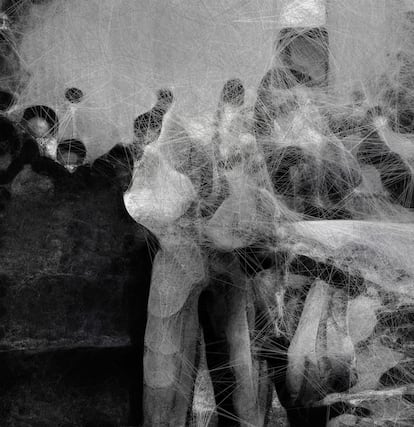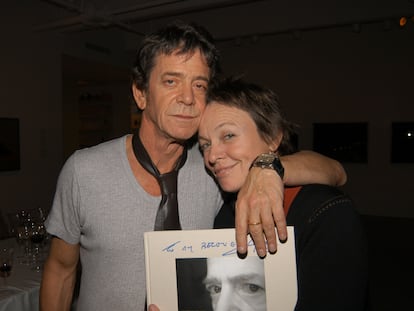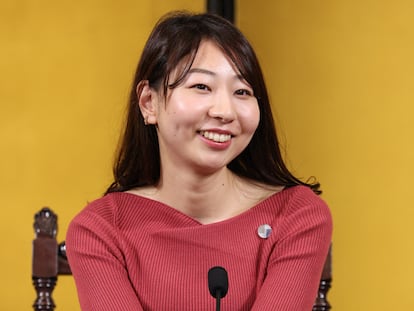Refik Anadol, the artist who brought AI to MoMA: ‘We’re in a new Renaissance’
The creator, who has collaborated with Google and Microsoft, emphasizes the fundamental role of ethics in using new AI tools


Futuristic movies like Blade Runner have always fascinated Istanbul-born Refik Anadol, especially ones with thinking machines. “I’ve been obsessed with the idea of teaming up with computers since I was eight — I’m a huge sci-fi fan,” said the artist who created Unsupervised (2023), the first exhibition to use generative artificial intelligence (AI) in New York’s Museum of Modern Art (MoMA). Anadol, whose work has been exhibited at prestigious venues like the Venice Biennale, the Pompidou-Metz Center (Paris), and Casa Batlló (Barcelona), told us that his projects aim to demystify algorithms. He delves into their potential to create, dream, and even “hallucinate.” Still, his work with AI comes at a time of intense ethical debates about these tools. While supporters say Analdol’s work is innovative, critics argue it merely serves as “propaganda” for tech giants.
Question: When did you start exploring the connection between art and artificial intelligence?
Answer: I’ve been into computing and art since high school, especially 3D design, photography, and videography. While studying multimedia art and design at UCLA, I really got into the idea of painting or sculpting with data. I wanted to blend these techniques into architectural design, transforming buildings into living canvases. As I built my team over the years, we delved into various repositories with data on things like beating hearts, the weather, and the brain. My AI journey kicked off in 2016 when I became Google’s first resident artist. Prior to that, I hadn’t really dabbled in AI formally, but that opportunity opened the door for me. In a span of eight years, we sifted through over 400 billion images, listened to 100 years’ worth of recordings, and combed through millions of articles and books. Our mission was to dive into the shared memory of humanity.
Q: Why did you choose data as your raw material?
A: Data lets us see the unseen. It’s like the language of the future, connecting us with machines and our surroundings. When I think about data, I don’t just see numbers — I see memories that can shape ideas and forms. It’s a whole new world of possibilities and vocabularies opening up.

Q: Why use artificial intelligence as an artistic tool?
A: Ever since I was a kid, I’ve always felt like machines could be an extension of ourselves, you know? It’s not like your average tool, like a paintbrush. AI, on the other hand, tries to mirror reality. But what really gets me going is wondering if it can truly learn, dream, or even have hallucinations. Art sometimes springs out of these unexpected hiccups and glitches that artificial intelligence produces. We’ve been at this for about eight years now, creating over 300 systems, and each time we train the models, we stumble upon something new. It’s not just about clicking buttons — we start from scratch every single time, and it’s always a different journey. Think of AI like a paintbrush that has a mind of its own.
AI has the right to see and learn everything it can, but I understand why people object
Q: You said AI can dream. Do you believe AI can be creative on its own?
A: Right now, it can’t quite create like humans. They’re simulations, and I like that. Maybe someday it’ll surpass our abilities and gain consciousness, but that’s a ways off. For now, I’m excited about its potential to craft new worlds and stories. It’s a whole new type of creativity.
Q: Do you think AI will one day be able to appreciate art on its own?
A: I think it’s possible. Perhaps one day Ai will pull it off, but it’ll always mirror us somehow. Until then, we’ll still search for that human touch, even in these machines and codes. I picture them evolving to feel empathy for humanity. Currently, they’re in a cold, algorithmic mode where they just mimic logic. If AI could make that leap forward, I think the spirituality and emotion that art evokes would be what initially inspires the AI.
Q: Can AI produce art that is fundamentally different from what humans can create?
A: The Unsupervised project tackles this issue. We trained a model with 820,000 images of MoMA art for a year to see if it could come up with something fresh. In our study, we tasked the system with imagining new shapes, colors and patterns without copying any existing piece. After all that, I realized that AI can invent new vocabularies, languages, styles and aesthetics. So, yes — I believe it can create new forms and languages. Honestly, I’m not certain if it’s on par with what humans can do or if it’s fundamentally different, but it’s definitely a powerful tool.
Q: How much effort does the artist put in versus the AI?
A: It’s about half and half. Artificial intelligence handles the basics like color, shape, and movement, and then we come in with the complexity. But I make sure we’re equal partners. It’s all about working together and creating stuff together.

Q: Besides museums, you’ve partnered with companies like Nvidia, a semiconductor manufacturer. Is art becoming more intertwined with the business sector?
A: Yeah, more and more. Companies like Google and Nvidia are totally transforming our lives with tech. Understanding its impact on society is key. I just had an an opportunity to share a stage with Nvidia’s CEO. It feels like we’re in a new Renaissance, when artists were commissioned by merchants to create art for churches and chapels. These partnerships open up endless possibilities. Artists are really pushing the boundaries on how we can use these technologies in ways we never thought possible.
Q: But a large part of the creative community opposes AI.
A: I understand why people have doubts. But here’s my way: I collect my own data and train my own models. Every artist using this tech should take ownership and responsibility. That’s how you do unique, groundbreaking, ethical stuff. We team up with museums that openly share their databases and information. AI opens doors, but it also implies responsibility. Artists must find ethical ways to create this kind of artwork.
AI opens doors, but also implies responsibility. Artists must find ethical ways to create this kind of artwork.
Q: What are your thoughts on tools trained with the intellectual property of other artists?
A: I feel like AI should be able to see and learn as much as possible. But I get why some people are not okay with that. It’s an ongoing debate. These tools are pretty amazing, but I think if you want to make something creatively groundbreaking, you must bring in that human touch.
Q: What excites you most about the future?
A: I appreciate the positive response to our recent exhibitions in London and Rotterdam, drawing in thousands of visitors. Our work unites people beyond just digital displays. By demystifying AI, we help people understand how it works and grasp its significance. Our upcoming project in Los Angeles in 2025 aims to pioneer an innovative artistic form, one that engages all of the senses. It’s an exciting new frontier we’re venturing into.
Sign up for our weekly newsletter to get more English-language news coverage from EL PAÍS USA Edition
Tu suscripción se está usando en otro dispositivo
¿Quieres añadir otro usuario a tu suscripción?
Si continúas leyendo en este dispositivo, no se podrá leer en el otro.
FlechaTu suscripción se está usando en otro dispositivo y solo puedes acceder a EL PAÍS desde un dispositivo a la vez.
Si quieres compartir tu cuenta, cambia tu suscripción a la modalidad Premium, así podrás añadir otro usuario. Cada uno accederá con su propia cuenta de email, lo que os permitirá personalizar vuestra experiencia en EL PAÍS.
¿Tienes una suscripción de empresa? Accede aquí para contratar más cuentas.
En el caso de no saber quién está usando tu cuenta, te recomendamos cambiar tu contraseña aquí.
Si decides continuar compartiendo tu cuenta, este mensaje se mostrará en tu dispositivo y en el de la otra persona que está usando tu cuenta de forma indefinida, afectando a tu experiencia de lectura. Puedes consultar aquí los términos y condiciones de la suscripción digital.
More information
Archived In
Últimas noticias
The new victims of the Republican war on Obamacare: Millions hit by soaring health insurance premiums
A country divided on migrant rights: Some US states expand protections while others restrict them
Venezuela authorizes the release of another 87 political prisoners
There is as much life left to discover on planet Earth as that which is already known
Most viewed
- David King, chemist: ‘There are scientists studying how to cool the planet; nobody should stop these experiments from happening’
- Reinhard Genzel, Nobel laureate in physics: ‘One-minute videos will never give you the truth’
- Oona Chaplin: ‘I told James Cameron that I was living in a treehouse and starting a permaculture project with a friend’
- Sinaloa Cartel war is taking its toll on Los Chapitos
- The Interoceanic Train, the Mexican alternative to the Panama Canal










































